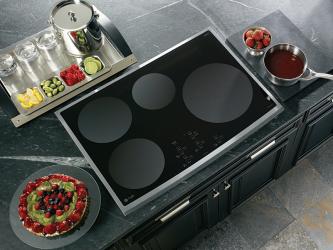Induction cooktops have been around since the early 1900s, when the first models were patented, with widespread production beginning in the United States in the ‘70s. While the appliance never lost appeal in Europe, Jane Heiling, president of Authorized Builder Sales, reports that here, “there was very little in the way of induction between 1985 and 2005.” Now, though, the induction flame’s been reignited (remagnetized, actually, but more on that later). “Today, it’s the most popular cooktop we sell,” Heiling says.
The appeal’s obvious: professional-grade, efficient, low-maintenance cooking. “Induction offers the same control of cooking you would have with gas,” explains Jean Herman, AUTCOhome appliance specialist. Users attain a high boil quickly and can scale back to simmer almost instantly. “With electric, there’s more waiting,” adds Herman.
It’s a common misconception that gas is the most efficient form of cooking, explains Heiling. Gas, only 38 percent efficient, is actually the least efficient form because significant heat escapes into the room. Induction, by contrast, is 98 percent efficient. Bonus: induction’s also safest. There’s no risk of a leak, and because the cooktop surface is heated by contact with cookware, there’s lower risk for burns.
The magic is magnetic. Underneath an induction range you’ll find magnetic generators, which “click to magnetic pans to create energy,” explains Herman. The pan, then, is the heating element; no need for a flame or red-hot surface, though you may need a little more amperage and different wiring than what you already have with an existing cooktop or range.
You’ll also need the right cookware – anything a magnet sticks to should suffice. “Something with high iron content is best,” Heiling says. Cast iron’s her favorite. While its burr bottom is rumored to scratch glass cooktops, the material’s safe for induction. (Psst: If you’re worried about scratching a surface, put paper towel underneath the pan; Heiling swears “you can cook right through, and it won’t catch fire.”)
Here’s another insider tip: you don’t have to buy high-end, All-Clad cookware. Most stores carry induction-ready vessels. Herman, in fact, found her favorite set at Costco. “A lot of times,” Heiling adds, “the proper cookware comes free with the cooktop.”
Ease-of-cleaning comes free, too. “I don’t baby the induction or any other glass top,” says Heiling. For daily cleaning, she uses Scotch-Brite pads and dish soap. Once a month, do a deeper clean with cream cooktop cleaner (any brand will do). A dime-sized dollop of cream goes onto the cooktop; work it in with a dry (never wet!) paper towel until it totally disappears. “That’s it,” says Heiling. “It is much easier to clean than burners with grates, et cetera.”
True, induction cooktops typically cost about 40 percent more than electric versions. But, says Herman, the good news is that prices have come down significantly in the past few years. Both AUTCOhome and Authorized Builder Sales keep their induction cooktops hooked up for in-store demos. What are you waiting for? Come try one today.
Resources:
AUTCOhome, 314-373-2000
Authorized Builder Sales, 314-429-0972





